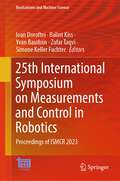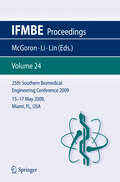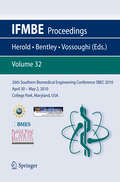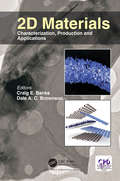- Table View
- List View
25th Congress Ampere on Magnetic Resonance and Related Phenomena: Extended Abstracts
by Michael Mehring Jost U. Schütz Hans C. WolfThis volume contains extended abstracts of the 10 plenary lectures, 27 invited symposium lectures and ap- proximately 300 contributed papers that were presented at the 25th Congress Ampère. The contributions cover the full range of magnetic resonance and radiospectroscopy and their applications in physics, chemical physics, medicine and biology. Advanced NMR and ESR techniques are treated, as are their applications to novel materials.
The 25th European Conference on Integrated Optics: Proceedings of ECIO 2024, June 17–19, Aachen, Germany (Springer Proceedings in Physics #402)
by Jeremy Witzens Joyce Poon Lars Zimmermann Wolfgang FreudeThis volume presents peer-reviewed and selected papers from the 2024 European Conference on Integrated Optics (ECIO), held on 17-19 June, 2024, and organized by RWTH Aachen University, Germany, in collaboration with Max-Planck Institute of Microstructure Physics, Technical University of Berlin, Leibniz Institute for High Performance Microelectronics, and Karlsruhe Institute of Technology. In the 25th edition of this conference, internationally recognized experts share their latest research and showcase their products and services in the field of integrated optics, optoelectronics, and nano-photonics. The conference focuses on leading-edge research and its broad application scope ranges from tele/datacom, optical interconnects, and (bio) optical sensing to more disruptive areas such as quantum computing and programmable photonics.
25th International Symposium on Measurements and Control in Robotics: Proceedings of ISMCR 2023 (Mechanisms and Machine Science #154)
by Ioan Doroftei Balint Kiss Yvan Baudoin Zafar Taqvi Simone Keller FuchterGathering the proceedings of the 25th International Symposium on Measurement and Control in Robotics (ISMCR), held in Iasi, Romania, on September 21-22, 2023, this volume covers topics in the broad range of topics related to robotics and human robot systems, such as robot design innovations, sensors/smart sensors their integration/fusion, advanced controls and actuators, methods of AI in robotics, humanoid, climbing/walking, and autonomous robots; anthropomorphic robots, augmented/mixed/virtual reality (VR), intelligent CAD and IMS, visual/auditory/tactile/force displays, tools and techniques for modelling VR systems, software architectures for VR, VR interaction and navigation techniques, distributed VR Systems, motion tracking, VR input and output devices, human factors in VR. The proceedings extend this platform to all researchers, scientists, industry experts, and students interested in these fields.
25th Southern Biomedical Engineering Conference 2009; 15 - 17 May, 2009, Miami, Florida, USA (IFMBE Proceedings #24)
by Anthony McGoron Chen-Zhong Li Wei-Chiang Linth On behalf of the steering and organizing committees I would like to welcome you to sunny Miami Florida for the 25 Sou- ern Biomedical Engineering Conference. This year we are excited to have visitors from all over North America, South American, Europe and Asia to share exciting developments in all areas of Biomedical Engineering. The main objective of this conference is to bring together students, researchers and clinicians in Biomedical Engineering to disseminate technical information in this rapidly growing field, and provide a forum consisting of established as well as new and future researchers in this exciting engineering field. This year’s meeting features more than 140 high quality papers, many by students, for oral presentations and publication in the conference proceedings. The conference owes its success to the dedicated work of the keynote speakers, conference chairs, authors, participants, students, organizers, and the College of Engineering and Computing webmaster. We wish to especially acknowledge the work of the peer reviewers, program committee, staff of the BME Department, and the student organizing committee. We also wish to acknowledge the sponsorship of the National Science Foundation and the International Federation of Medical and Biological Engineering, and Simpleware, Ltd. We hope that you enjoy your experience, make new collaborations and lasting friendships.
26th Annual Conference on Composites, Advanced Ceramics, Materials, and Structures - A (Ceramic Engineering and Science Proceedings #258)
by Mrityunjay Singh Hua-Tay LinThis volume is part of the Ceramic Engineering and Science Proceeding (CESP) series. This series contains a collection of papers dealing with issues in both traditional ceramics (i.e., glass, whitewares, refractories, and porcelain enamel) and advanced ceramics. Topics covered in the area of advanced ceramic include bioceramics, nanomaterials, composites, solid oxide fuel cells, mechanical properties and structural design, advanced ceramic coatings, ceramic armor, porous ceramics, and more.
26th Annual Conference on Composites, Advanced Ceramics, Materials, and Structures - B (Ceramic Engineering and Science Proceedings #260)
by Mrityunjay Singh Hua-Tay LinThis volume is part of the Ceramic Engineering and Science Proceeding (CESP) series. This series contains a collection of papers dealing with issues in both traditional ceramics (i.e., glass, whitewares, refractories, and porcelain enamel) and advanced ceramics. Topics covered in the area of advanced ceramic include bioceramics, nanomaterials, composites, solid oxide fuel cells, mechanical properties and structural design, advanced ceramic coatings, ceramic armor, porous ceramics, and more.
26th Southern Biomedical Engineering ConferenceSBEC 2010 April 30 - May 2, 2010 College Park, Maryland, USA (IFMBE Proceedings #32)
by Keith Herold William E. Bentley Jafar VossoughiThe 26th Southern Biomedical Engineering Conference was hosted by the Fischell Department of Bioengineering and the A. James Clark School of Engineering from April 30 – May 2 2010.. The conference program consisted of 168 oral presentations and 21 poster presentations with approximately 250 registered participants of which about half were students. The sessions were designed along topical lines with student papers mixed in randomly with more senior investigators. There was a Student Competition resulting in several Best Paper and Honorable Mention awards. There were 32 technical sessions occurring in 6-7 parallel sessions. This Proceedings is a subset of the papers submitted to the conference. It includes 147 papers organized in topical areas. Many thanks go out to the paper reviewers who significantly improved the clarity of the submitted papers.
27th Annual Cocoa Beach Conference on Advanced Ceramics and Composites - A (Ceramic Engineering and Science Proceedings #268)
by Waltraud M. Kriven Hua-Tay LinThis volume is part of the Ceramic Engineering and Science Proceeding (CESP) series. This series contains a collection of papers dealing with issues in both traditional ceramics (i.e., glass, whitewares, refractories, and porcelain enamel) and advanced ceramics. Topics covered in the area of advanced ceramic include bioceramics, nanomaterials, composites, solid oxide fuel cells, mechanical properties and structural design, advanced ceramic coatings, ceramic armor, porous ceramics, and more.
27th Annual Cocoa Beach Conference on Advanced Ceramics and Composites - B (Ceramic Engineering and Science Proceedings #270)
by Waltraud M. Kriven Hua-Tay LinThis volume is part of the Ceramic Engineering and Science Proceeding (CESP) series. This series contains a collection of papers dealing with issues in both traditional ceramics (i.e., glass, whitewares, refractories, and porcelain enamel) and advanced ceramics. Topics covered in the area of advanced ceramic include bioceramics, nanomaterials, composites, solid oxide fuel cells, mechanical properties and structural design, advanced ceramic coatings, ceramic armor, porous ceramics, and more.
28th International Conference on Advanced Ceramics and Composites A (Ceramic Engineering and Science Proceedings #278)
by Edgar Lara-Curzio Michael J. ReadeyA collection of Papers Presented at the 28th International Conference and Exposition on Advanced Ceramics and Composites held in conjunction with the 8th International Symposium on Ceramics in Energy Storage and Power Conversion Systems.
28th International Conference on Advanced Ceramics and Composites B (Ceramic Engineering and Science Proceedings #280)
by Edgar Lara-Curzio Michael J. ReadeyA collection of Papers Presented at the 28th International Conference and Exposition on Advanced Ceramics and Composites held in conjunction with the 8th International Symposium on Ceramics in Energy Storage and Power Conversion Systems.
28th International Symposium on Shock Waves: Vol 1
by Konstantinos KontisThe University of Manchester hosted the 28th International Symposium on Shock Waves between 17 and 22 July 2011. The International Symposium on Shock Waves first took place in 1957 in Boston and has since become an internationally acclaimed series of meetings for the wider Shock Wave Community. The ISSW28 focused on the following areas: Blast Waves, Chemically Reacting Flows, Dense Gases and Rarefied Flows, Detonation and Combustion, Diagnostics, Facilities, Flow Visualisation, Hypersonic Flow, Ignition, Impact and Compaction, Multiphase Flow, Nozzle Flow, Numerical Methods, Propulsion, Richtmyer-Meshkov, Shockwave Boundary Layer Interaction, Shock Propagation and Reflection, Shock Vortex Interaction, Shockwave Phenomena and Applications, as well as Medical and Biological Applications. The two Volumes contain the papers presented at the symposium and serve as a reference for the participants of the ISSW 28 and individuals interested in these fields.
28th International Symposium on Shock Waves: Vol 2
by Konstantinos KontisThe University of Manchester hosted the 28th International Symposium on Shock Waves between 17 and 22 July 2011. The International Symposium on Shock Waves first took place in 1957 in Boston and has since become an internationally acclaimed series of meetings for the wider Shock Wave Community. The ISSW28 focused on the following areas: Blast Waves, Chemically Reacting Flows, Dense Gases and Rarefied Flows, Detonation and Combustion, Diagnostics, Facilities, Flow Visualisation, Hypersonic Flow, Ignition, Impact and Compaction, Multiphase Flow, Nozzle Flow, Numerical Methods, Propulsion, Richtmyer-Meshkov, Shockwave Boundary Layer Interaction, Shock Propagation and Reflection, Shock Vortex Interaction, Shockwave Phenomena and Applications, as well as Medical and Biological Applications. The two Volumes contain the papers presented at the symposium and serve as a reference for the participants of the ISSW 28 and individuals interested in these fields.
29th International Symposium on Shock Waves 1: Volume 1
by Riccardo Bonazza Devesh RanjanThis proceedings present the results of the 29th International Symposium on Shock Waves (ISSW29) which was held in Madison, Wisconsin, U.S.A., from July 14 to July 19, 2013. It was organized by the Wisconsin Shock Tube Laboratory, which is part of the College of Engineering of the University of Wisconsin-Madison. The ISSW29 focused on the following areas: Blast Waves, Chemically Reactive Flows, Detonation and Combustion, Facilities, Flow Visualization, Hypersonic Flow, Ignition, Impact and Compaction, Industrial Applications, Magnetohydrodynamics, Medical and Biological Applications, Nozzle Flow, Numerical Methods, Plasmas, Propulsion, Richtmyer-Meshkov Instability, Shock-Boundary Layer Interaction, Shock Propagation and Reflection, Shock Vortex Interaction, Shock Waves in Condensed Matter, Shock Waves in Multiphase Flow, as well as Shock Waves in Rarefield Flow. The two Volumes contain the papers presented at the symposium and serve as a reference for the participants of the ISSW 29 and individuals interested in these fields.
29th International Symposium on Shock Waves 2: Volume 2
by Riccardo Bonazza Devesh RanjanThis proceedings present the results of the 29th International Symposium on Shock Waves (ISSW29) which was held in Madison, Wisconsin, U.S.A., from July 14 to July 19, 2013. It was organized by the Wisconsin Shock Tube Laboratory, which is part of the College of Engineering of the University of Wisconsin-Madison. The ISSW29 focused on the following areas: Blast Waves, Chemically Reactive Flows, Detonation and Combustion, Facilities, Flow Visualization, Hypersonic Flow, Ignition, Impact and Compaction, Industrial Applications, Magnetohydrodynamics, Medical and Biological Applications, Nozzle Flow, Numerical Methods, Plasmas, Propulsion, Richtmyer-Meshkov Instability, Shock-Boundary Layer Interaction, Shock Propagation and Reflection, Shock Vortex Interaction, Shock Waves in Condensed Matter, Shock Waves in Multiphase Flow, as well as Shock Waves in Rarefield Flow. The two Volumes contain the papers presented at the symposium and serve as a reference for the participants of the ISSW 29 and individuals interested in these fields.
2D and 3D Graphene Nanocomposites: Fundamentals, Design, and Devices
by Olga GlukhovaIn recent decades, graphene composites have received considerable attention due to their unique structural features and extraordinary properties. 2D and 3D graphene hybrid structures are widely used in memory, microelectronic, and optoelectronic devices; energy- and power-density supercapacitors; light-emitting diodes; and sensors, batteries, and solar cells. This book covers the fundamental properties of the latest graphene-based 2D and 3D composite materials. The book is a result of the collective work of many highly qualified specialists in the field of experimental and theoretical research on graphene and its derivatives. It describes experimental methods for obtaining and characterizing samples of chemically modified graphene, details conceptual foundations of popular methods for computer modeling of graphene nanostructures, and compiles original computational techniques developed by the chapter authors. It discusses the potential application areas and modifications of graphene-based 2D and 3D composite materials and interprets the interesting physical effects discovered for the first time for graphene materials under consideration. The book is useful for graduate students and researchers as well as specialists in industrial engineering. It will also appeal to those involved in materials science, condensed matter physics, nanotechnology, physical electronics, nano- and optoelectronics.
2D and 3D Graphene Nanocomposites: Fundamentals, Design, and Devices
by Olga GlukhovaIn recent decades, graphene composites have received considerable attention due to their unique structural features and extraordinary properties. 2D and 3D graphene hybrid structures are widely used in memory, microelectronic, and optoelectronic devices; energy- and power-density supercapacitors; light-emitting diodes; and sensors, batteries, and solar cells. This book covers the fundamental properties of the latest graphene-based 2D and 3D composite materials. The book is a result of the collective work of many highly qualified specialists in the field of experimental and theoretical research on graphene and its derivatives. It describes experimental methods for obtaining and characterizing samples of chemically modified graphene, details conceptual foundations of popular methods for computer modeling of graphene nanostructures, and compiles original computational techniques developed by the chapter authors. It discusses the potential application areas and modifications of graphene-based 2D and 3D composite materials and interprets the interesting physical effects discovered for the first time for graphene materials under consideration. The book is useful for graduate students and researchers as well as specialists in industrial engineering. It will also appeal to those involved in materials science, condensed matter physics, nanotechnology, physical electronics, nano- and optoelectronics.
2D and 3D Image Analysis by Moments
by Jan Flusser Tomas Suk Barbara ZitovaPresents recent significant and rapid development in the field of 2D and 3D image analysis 2D and 3D Image Analysis by Moments, is a unique compendium of moment-based image analysis which includes traditional methods and also reflects the latest development of the field. The book presents a survey of 2D and 3D moment invariants with respect to similarity and affine spatial transformations and to image blurring and smoothing by various filters. The book comprehensively describes the mathematical background and theorems about the invariants but a large part is also devoted to practical usage of moments. Applications from various fields of computer vision, remote sensing, medical imaging, image retrieval, watermarking, and forensic analysis are demonstrated. Attention is also paid to efficient algorithms of moment computation. Key features: Presents a systematic overview of moment-based features used in 2D and 3D image analysis. Demonstrates invariant properties of moments with respect to various spatial and intensity transformations. Reviews and compares several orthogonal polynomials and respective moments. Describes efficient numerical algorithms for moment computation. It is a "classroom ready" textbook with a self-contained introduction to classifier design. The accompanying website contains around 300 lecture slides, Matlab codes, complete lists of the invariants, test images, and other supplementary material. 2D and 3D Image Analysis by Moments, is ideal for mathematicians, computer scientists, engineers, software developers, and Ph.D students involved in image analysis and recognition. Due to the addition of two introductory chapters on classifier design, the book may also serve as a self-contained textbook for graduate university courses on object recognition.
2D and 3D Image Analysis by Moments
by Jan Flusser Tomas Suk Barbara ZitovaPresents recent significant and rapid development in the field of 2D and 3D image analysis 2D and 3D Image Analysis by Moments, is a unique compendium of moment-based image analysis which includes traditional methods and also reflects the latest development of the field. The book presents a survey of 2D and 3D moment invariants with respect to similarity and affine spatial transformations and to image blurring and smoothing by various filters. The book comprehensively describes the mathematical background and theorems about the invariants but a large part is also devoted to practical usage of moments. Applications from various fields of computer vision, remote sensing, medical imaging, image retrieval, watermarking, and forensic analysis are demonstrated. Attention is also paid to efficient algorithms of moment computation. Key features: Presents a systematic overview of moment-based features used in 2D and 3D image analysis. Demonstrates invariant properties of moments with respect to various spatial and intensity transformations. Reviews and compares several orthogonal polynomials and respective moments. Describes efficient numerical algorithms for moment computation. It is a "classroom ready" textbook with a self-contained introduction to classifier design. The accompanying website contains around 300 lecture slides, Matlab codes, complete lists of the invariants, test images, and other supplementary material. 2D and 3D Image Analysis by Moments, is ideal for mathematicians, computer scientists, engineers, software developers, and Ph.D students involved in image analysis and recognition. Due to the addition of two introductory chapters on classifier design, the book may also serve as a self-contained textbook for graduate university courses on object recognition.
2D Boron: Boraphene, Borophene, Boronene
by Iwao Matsuda Kehui WuThis book addresses the development, properties, and applications of atomic-layered boron, or, borophene. The authors explain how borophene was predicted and created before investigating the properties that make it a desirable and useful material. The material is extremely thin and possesses exotic quantum states of new Dirac physics. Applications in superconductivity, plasmonics, and industrial chemical catalysis are examined, along with an examination of the material’s unique hydrogen boride and boron nitride forms. Given the varied potential uses for the new-developed borophene, this timely book will be useful to researchers in academia and industry.
2D Electrostatic Fields: A Complex Variable Approach
by Robert L. CoffieThis book demonstrates how to use functions of a complex variable to solve engineering problems that obey the 2D Laplace equation (and in some cases the 2D Poisson equation). The book was written with the engineer/physicist in mind and the majority of the book focuses on electrostatics. A key benefit of the complex variable approach to electrostatics is the visualization of field lines through the use of field maps. With todays’ powerful computers and mathematical software programs, field maps are easily generated once the complex potential has been determined. Additionally, problems that would have been considered out of scope previously are now easily solved with these mathematical software programs. For example, solutions requiring the use of non-elementary functions such as elliptic and hypergeometric functions would have been viewed as not practical in the past due to the tedious use of look up tables for evaluation. Now, elliptic and hypergeometric functions are built-in functions for most mathematical software programs making their evaluation as easy as a trigonometric function. Key highlights in the book include 2D electrostatics completely formulated in terms of complex variables More than 60 electrostatic field maps Comprehensive treatment for obtaining Green’s functions with conformal mapping Fully worked Schwarz-Christoffel transformations to more than usual number of problems A full chapter devoted to solving practical problems at an advanced level Detailed solutions to all end of chapter problems available on book’s website Although the text is primarily self-contained, the reader is assumed to have taken differential and integral calculus and introductory courses in complex variables and electromagnetics.
2D Electrostatic Fields: A Complex Variable Approach
by Robert L. CoffieThis book demonstrates how to use functions of a complex variable to solve engineering problems that obey the 2D Laplace equation (and in some cases the 2D Poisson equation). The book was written with the engineer/physicist in mind and the majority of the book focuses on electrostatics. A key benefit of the complex variable approach to electrostatics is the visualization of field lines through the use of field maps. With todays’ powerful computers and mathematical software programs, field maps are easily generated once the complex potential has been determined. Additionally, problems that would have been considered out of scope previously are now easily solved with these mathematical software programs. For example, solutions requiring the use of non-elementary functions such as elliptic and hypergeometric functions would have been viewed as not practical in the past due to the tedious use of look up tables for evaluation. Now, elliptic and hypergeometric functions are built-in functions for most mathematical software programs making their evaluation as easy as a trigonometric function. Key highlights in the book include 2D electrostatics completely formulated in terms of complex variables More than 60 electrostatic field maps Comprehensive treatment for obtaining Green’s functions with conformal mapping Fully worked Schwarz-Christoffel transformations to more than usual number of problems A full chapter devoted to solving practical problems at an advanced level Detailed solutions to all end of chapter problems available on book’s website Although the text is primarily self-contained, the reader is assumed to have taken differential and integral calculus and introductory courses in complex variables and electromagnetics.
2D Functional Nanomaterials: Synthesis, Characterization, and Applications
by Ganesh S Kamble2D Functional Nanomaterials Outlines the latest developments in 2D heterojunction nanomaterials with energy conversion applications In 2D Functional Nanomaterials: Synthesis, Characterization, and Applications, Dr. Ganesh S. Kamble presents an authoritative overview of the most recent progress in the rational design and synthesis of 2D nanomaterials and their applications in semiconducting catalysts, biosensors, electrolysis, batteries, and solar cells. This interdisciplinary volume is a valuable resource for materials scientists, electrical engineers, nanoscientists, and solid-state physicists looking for up-to-date information on 2D heterojunction nanomaterials. The text summarizes the scientific contributions of international experts in the fabrication and application of 2D nanomaterials while discussing the importance and impact of 2D nanomaterials on future economic growth, novel manufacturing processes, and innovative products. Provides thorough coverage of graphene chemical derivatives synthesis and applications, including state-of-the-art developments and perspectives Describes 2D/2D graphene oxide-layered double hydroxide nanocomposites for immobilization of different radionuclides Covers 2D nanomaterials for biomedical applications and novel 2D nanomaterials for next-generation photodetectors Discusses applications of 2D nanomaterials for cancer therapy and recent trends ingraphene-latex nanocomposites Perfect for materials scientists, inorganic chemists, and electronics engineers, 2D Functional Nanomaterials: Synthesis, Characterization, and Applications is also an essential resource for solid-state physicists seeking accurate information on recent progress in two-dimensional heterojunction materials with energy conversion applications.
2D Functional Nanomaterials: Synthesis, Characterization, and Applications
by Ganesh S. Kamble2D Functional Nanomaterials Outlines the latest developments in 2D heterojunction nanomaterials with energy conversion applications In 2D Functional Nanomaterials: Synthesis, Characterization, and Applications, Dr. Ganesh S. Kamble presents an authoritative overview of the most recent progress in the rational design and synthesis of 2D nanomaterials and their applications in semiconducting catalysts, biosensors, electrolysis, batteries, and solar cells. This interdisciplinary volume is a valuable resource for materials scientists, electrical engineers, nanoscientists, and solid-state physicists looking for up-to-date information on 2D heterojunction nanomaterials. The text summarizes the scientific contributions of international experts in the fabrication and application of 2D nanomaterials while discussing the importance and impact of 2D nanomaterials on future economic growth, novel manufacturing processes, and innovative products. Provides thorough coverage of graphene chemical derivatives synthesis and applications, including state-of-the-art developments and perspectives Describes 2D/2D graphene oxide-layered double hydroxide nanocomposites for immobilization of different radionuclides Covers 2D nanomaterials for biomedical applications and novel 2D nanomaterials for next-generation photodetectors Discusses applications of 2D nanomaterials for cancer therapy and recent trends ingraphene-latex nanocomposites Perfect for materials scientists, inorganic chemists, and electronics engineers, 2D Functional Nanomaterials: Synthesis, Characterization, and Applications is also an essential resource for solid-state physicists seeking accurate information on recent progress in two-dimensional heterojunction materials with energy conversion applications.
2D Materials: Characterization, Production and Applications
by Craig E. Banks Dale A. C. BrownsonMost reference texts covering two-dimensional materials focus specifically on graphene, when in reality, there are a host of new two-dimensional materials poised to overtake graphene. This book provides an authoritative source of information on twodimensional materials covering a plethora of fields and subjects and outlining all two-dimensional materials in terms of their fundamental understanding, synthesis, and applications.




















